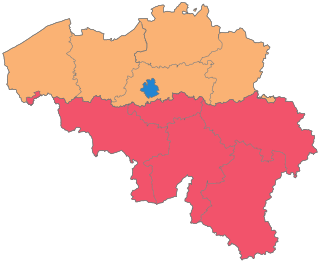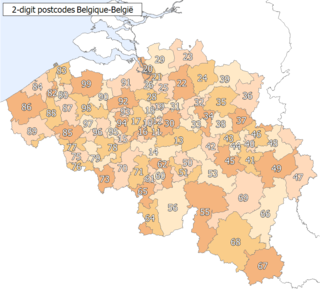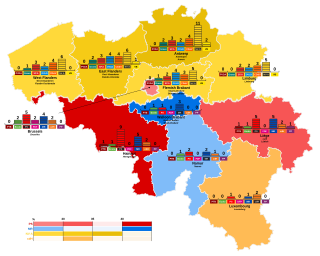
Transport in Belgium is facilitated with well-developed road, air, rail and water networks. The rail network has 2,950 km (1,830 mi) of electrified tracks. There are 118,414 km (73,579 mi) of roads, among which there are 1,747 km (1,086 mi) of motorways, 13,892 km (8,632 mi) of main roads and 102,775 km (63,861 mi) of other paved roads. There is also a well-developed urban rail network in Brussels, Antwerp, Ghent and Charleroi. The ports of Antwerp and Bruges-Zeebrugge are two of the biggest seaports in Europe. Brussels Airport is Belgium's biggest airport.

Flemish Brabant is a province of Flanders, one of the three regions of Belgium. It borders on the Belgian provinces of Antwerp, Limburg, Liège, Walloon Brabant, Hainaut and East Flanders. Flemish Brabant also surrounds the Brussels-Capital Region. Its capital is Leuven. It has an area of 2,118 km2 (818 sq mi) which is divided into two administrative districts containing 65 municipalities. As of January 2024, Flemish Brabant had a population of over 1.19 million.

Belgium is a federal state comprising three communities and three regions that are based on four language areas. For each of these subdivision types, the subdivisions together make up the entire country; in other words, the types overlap.

The Kingdom of Belgium is divided into three regions. Two of these regions, Flanders and Wallonia, are each subdivided into five provinces. The third region, Brussels, does not belong to any province, nor is it subdivided into provinces. Instead, it has amalgamated both regional and provincial functions into a single "Capital Region" administration.
Articles related to Belgium include:

Brussels-Halle-Vilvoorde is a judicial arrondissement encompassing the bilingual—French and Dutch—Brussels-Capital Region, which coincides with the administrative arrondissement of Brussels-Capital and the surrounding Dutch-speaking area of Halle-Vilvoorde, which in turn coincides with the administrative arrondissement of Halle-Vilvoorde. Halle-Vilvoorde contains several municipalities with language facilities, i.e. municipalities where French-speaking people form a considerable part of the population and therefore have special language rights. The arrondissment is the location of a tribunal of first instance, enterprise tribunal and a labour tribunal.

The Flemish Diamond is the Flemish reference to a network of four metropolitan areas in Belgium, three of which are in the central provinces of Flanders, together with the Brussels-Capital Region. It consists of four agglomerations which form the four corners of an abstract diamond shape: Brussels, Ghent, Antwerp and Leuven.
Arrondissements of Belgium are subdivisions below the provinces of Belgium. There are administrative, judicial and electoral arrondissements. These may or may not relate to identical geographical areas.

The Flemish Heraldic Council advises the Flemish Government on all matters relating to heraldry. The Council was created on 11 April 1984, as the successor to the Subcommittee for Heraldry or Subcommissie Heraldiek, established in 1978. Its prime task was to supervise the granting of a coat of arms and a flag to all municipalities of the Flemish Region. Following the reorganization of the Belgian provinces, the council's field of action was extended to provincial arms and flags in 1994. Since 2000, the Council has likewise advised the Flemish Government on grants of arms to Flemish individuals and corporations. In the meantime, more than 200 such grants have received official sanction. Grants of arms by the Flemish Government are published in the Belgian official journal.

The Halle-Vilvoorde Arrondissement is one of the two administrative arrondissements in the Belgian province of Flemish Brabant. It almost completely surrounds the Brussels-Capital Region and lies to the west of the other arrondissement in the province, the Leuven Arrondissement. Unlike the Arrondissement of Leuven, it is not a judicial arrondissement; however since the sixth Belgian state reform in 2012–14, it has its own public prosecutor's service.

The Arrondissement of Brussels-Capital is the only administrative arrondissement in the Brussels-Capital Region of Belgium. Because it is the only administrative arrondissement in the Brussels Region, its territory coincides with that of the latter.

The Union of Francophones is a political party in Belgium that participates as electoral lists in regional, provincial, and municipal elections in the Flemish Province of Flemish Brabant. As its name suggests, its primary target is the French-speaking community of Flemish Brabant and particularly those who live in the officially Dutch-speaking area Halle-Vilvoorde including the now predominantly French-speaking municipalities with language facilities in the Brussels Periphery. Its main goal is to provide both constitutional exemptions for and privileges to Francophones living in Dutch-speaking Flanders, for example by annexing the municipalities with language facilities to the officially bilingual Brussels-Capital Region.

State reform, in the context of Belgium, is the ongoing process of seeking and finding constitutional and legal solutions to the problems and tensions in the different segments of the Belgian population, mostly between the Dutch-speakers of Flanders and the French-speakers of Wallonia. In general, Belgium has evolved from a unitary state to a federal state with communities, regions, and language areas.

An election of the delegation from Belgium to the European Parliament was held on Sunday, 7 June 2009. The elections were on the same day as regional elections to the Flemish Parliament, Walloon Parliament, Brussels Parliament and the Parliament of the German-speaking Community.
The N2 road in Belgium is a road connecting Brussels and Maastricht passing Leuven, Diest and Hasselt. It starts in Brussels at the Madou crossroad on the small ring, heading northeast as the Chaussée de Louvain/Leuvensesteenweg, which crosses the municipalities of Saint-Josse-ten-Noode, City of Brussels, Schaerbeek, Evere and Woluwe-Saint-Lambert in Brussels, and then enter Flanders via the municipality of Zaventem, Flemish Brabant.

Postal codes in Belgium are numeric and consist of 4 numbers. The first digit indicates the province. The more zeros there are, the higher the number of inhabitants of that city in the province. For example: Bruges (Brugge) is the capital and largest urban centre of the coastal province of West Flanders so it gets the 8000 code, the second city is Kortrijk and gets 8500. When writing the address, the postal code is put in front of the town name.

The N3 road in Belgium is a national road connecting the capital city Brussels to Aachen in Germany via Leuven, Tienen, Sint-Truiden and Liège. Its course is quite similar to that of European route E40 between Brussels and Aachen, which it intersects 3 times. The road runs through the 3 Belgian regions and the 3 communities.

Federal elections were held in Belgium on 25 May 2014. All 150 members of the Chamber of Representatives were elected, whereas the Senate was no longer directly elected following the 2011–2012 state reform. These were the first elections held under King Philippe's reign.















